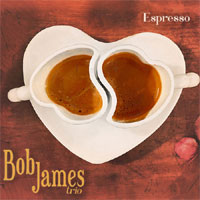Bob James Trio • Espresso
 ost audiophiles associate Bob James with smooth jazz. He was one
of the pioneers of the genre, along with his group, Fourplay. But there is another side to
Bob James that fewer people know about, that of a straight-ahead jazz pianist. Espresso
is one the few albums James has recorded over the years that has kept his name in front of
those who follow all manner of jazz. If that surprises you, maybe that accounts for some
of the fun James had in recording this trio date. Opening the jewel box presents you with
a picture of James with a "got ya" look on his face, the sentiment of which will
become apparent after the opening track. James is a master at varying the intensity of the
music, raising and lowering the tempo to suit the tunes' needs. He tends to push his music
along. Introspective he is not, but he also never lets things get out of hand. ost audiophiles associate Bob James with smooth jazz. He was one
of the pioneers of the genre, along with his group, Fourplay. But there is another side to
Bob James that fewer people know about, that of a straight-ahead jazz pianist. Espresso
is one the few albums James has recorded over the years that has kept his name in front of
those who follow all manner of jazz. If that surprises you, maybe that accounts for some
of the fun James had in recording this trio date. Opening the jewel box presents you with
a picture of James with a "got ya" look on his face, the sentiment of which will
become apparent after the opening track. James is a master at varying the intensity of the
music, raising and lowering the tempo to suit the tunes' needs. He tends to push his music
along. Introspective he is not, but he also never lets things get out of hand.
Right from the opening track, "Bulgogi," James plays surprisingly modern jazz, with the assistance of bassist Michael Palazzolo and drummer Billy Kilson. James spends the first half of this album showing that he can hold his own with any jazz pianist you’d care to name. By the halfway point, he veers back to a smooth-jazz groove he’s so well known for, but even then he does it with style and verve. While you’ll hear no displays of pyrotechnics, you will hear a musician who knows both his history and himself as a pianist. He always seems to find exactly the right phrase for exactly the right moment. For the discussion of the sound of this recording, I listened to three distinct digital versions of the same mastering job on two discs: 16-bit/44.1kHz PCM and DSD on hybrid SACD, and MQA-encoded data on CD. Both will play on any CD/SACD player, but MQA must be decoded by an appropriate DAC -- and you must use a drive that can pass it. I began with the SACD. Right from the opening track, Billy Kilson’s cymbal work shimmered, with the ting of wood stick on brass cymbal being readily apparent. There was also a good sense of just where on the cymbal he was striking. James's piano had both weight and delicacy, and Palazzolo’s bass was full of woody depth, with good definition to his plucks. When I switched to the CD layer, I heard exactly what I expected: a diminishment of the SACD's splendor, as well as a significant lessening to the sense of recording acoustic. For Red Book CD, this was still fine sound. It just lost out to the higher resolution of the SACD. When I played the MQA layer of the CD through an MQA DAC, things were a lot closer to the SACD. While I still preferred the sound of the SACD, if I had to live with the MQA CD, I wouldn’t feel I was missing out. The MQA CD offered almost everything the SACD layer did. While some of the finest detail was diminished, MQA offered a better sense of space and more precise soundstaging, which surprised me. I guess there’s more to MQA in sonic terms than we’ve been led to believe. The only issue I had was actually playing the MQA layer. I had to play the disc with my MacBook Pro, passing the signal to the DAC via USB, because my Oppo Blu-ray player wouldn’t pass the MQA data via coaxial or optical output. Of course, the SACD didn’t have that issue; it was just open, put in disc and hit play. Other than that, there was little to differentiate the two versions, and the differences I note could be due to the different playback hardware. In fact, I would expect that to be the case. Far too many jazz buffs will write off Bob James as
simply a smooth-jazz player, but this album shows what James can accomplish in a typical
small-group setting. He is, first and foremost, a jazz pianist, a complete jazz musician,
as Espresso demonstrates. About the only decision you really need to make is simply
which of the two discs meets your needs (to complicate things, Espresso is also
available on 180-gram LP). |
